| Columns Retired Columns & Blogs |
Jadis RC JP80 MC Mk.II preamplifier Measurementseth
Sidebar 3: Measurements
The output impedance of the Jadis JP 80 MC Mk.II at its main outputs measured 990 ohms, varying no more than ±10 ohms, depending on the channel and the setting of the level control. The line-level input impedance was 110k ohms in the left channel, 101k ohms in the right at the maximum setting of the level control. The latter increased slightly, but not significantly, as the level control was decreased (122k ohms in the left channel at unity gain—about 2:30 on the level control).
The moving-magnet phono input impedance measured 49.7k ohms, the moving-coil input impedance much higher than spec. at 1856 ohms. The output impedance at the tape outputs was a very high 16.5k ohms, and while this value does not vary as the source impedance changes, it is high enough to seriously compromise the tape outputs for actual taping, unless the recorder has an unusually high input impedance.
The DC offset at the Jadis' outputs measured 3.1mV left and 4.5mV right. These are the measured maximums; the actual values fluctuated considerably due tot he presence of low-frequency noise, not unusual in a tube design. The preamp is noninverting at its line and moving-magnet inputs, but inverting from itsmoving-coil input. Line-level gain (input to line output) measured a modest 6.5dB. The moving-magnet phono gain, measured at the tape outputs, is 34.7dB; the moving-coil phono gain is 57dB. The volume control has good tracking, varying no more than 0.2dB from 9:00 to full volume.
The line-level signal/noise ratio (reference 1V) measured 85dB unweighted from 22Hz to 22kHz, 70.8dB unweighted from 10Hz to 500kHz, and 88.4dB A-weighted. Phono S/N measured 76dB MM (68dB, MC) from 22Hz to 22kHz, 62.5dB MM (65dB, MC) from 10Hz to 500kHz, and 85dB MM (77.2dB) A-weighted. (The phono S/N figures given are for the worse channel—left for MM, right for MC—but are still good.) The increased noise measured with the wider bandwidth was primarily high-frequency in nature. The Jadis' noise also varies considerably with grounding; the optimum scheme will vary with the system, and the user should experiment for best results.
The JP 80 MC Mk.II's frequency response is shown in fig.1. The gradual decrease at low frequencies in the phono stage might cause a subtle loss of bass weight, but the actual value (about 0.5dB) is small. Fig.2 shows the Jadis' channel separation. Note that the left-to-right and right-to-left line crosstalk curves are overlaid precisely and appear here as one curve; the phono crosstalk also varies only slightly—and then only around 1.5kHz.
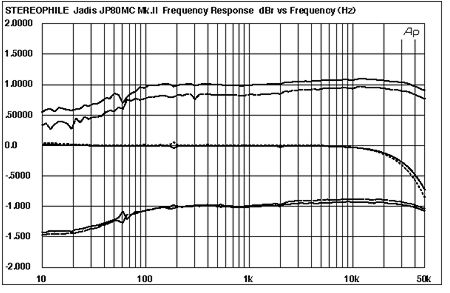
Fig.1 Jadis RC JP80 MC, frequency response at 1V into 100k ohms (from top to bottom): MC input, line input, MM input (0.5dB/vertical div., right channel dashed).
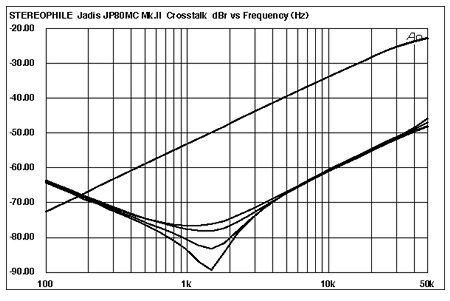
Fig.2 Jadis RC JP80 MC, crosstalk (from top to bottom at 1kHz): L-R, R-L, line; L-R, R-L, MM; L-R, R-L, MC (10dB/vertical div.).
The THD+noise percentage plotted against frequency for the Jadis is shown in fig.3. The level are generally low, but the increase in high-frequency distortion in two of the curves is due to the use of high input levels to minimize the effects of noise on the measurements. These levels are reflected in the minimums in the THD+noise vs output voltage curves of fig.4—which correspond approximately to inputs of 3.8V for the line stage, 56mV for the MM input, and 7mV for the MC input. The curve for the line stage in this figure ends prior to the maximum x value of the chosen scale, due to the combination of the preamp's relatively low gain and the maximum output voltage from our Audio Precision test set.
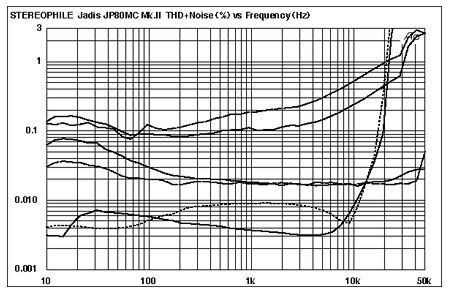
Fig.3 Jadis RC JP80 MC, THD+noise vs frequency at 1V into 100k ohms(from top to bottom at 1kHz): MC, MM, line.
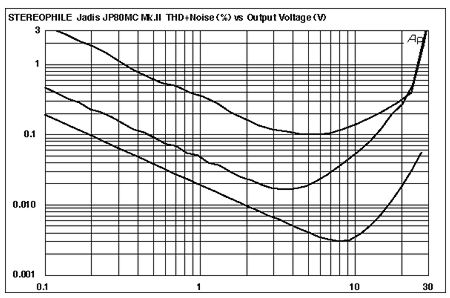
Fig.4 Jadis RC JP80 MC, distortion (%) vs continuous output voltage into 100k ohms (from top to bottom): MC, MM, line.
The output spectrum of the Jadis to a 50Hz input at a high output level of 10V is plotted in fig.5. This is an excellent result, with the highest harmonic (the second at 100Hz) barely higher than -80dB (0.01%).
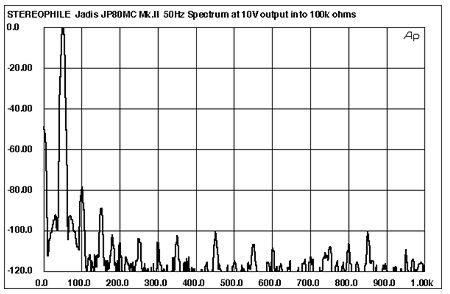
Fig.5 Jadis RC JP80 MC, output spectrum, DC-1kHz, 50Hz at 10V into 100k ohms (linear frequency scale).
The Jadis' MM phono input overloaded (1% THD+noise) at an input level of 460mV at 1kHz (39dB headroom above the standard MM output reference of 5mV), 1.42V at 20kHz (29.9dB), and 35mV at 20Hz (36.9dB). This indicates superb headroom. The corresponding figures for the MC input are 35mV at 1kHz (36.9dB above the standard MC output reference of 0.5mV), 102mV at 20kHz (26.2dB), and 34.2mV at 20Hz (34.3dB). Again, these are outstanding overload margins.
Finally, JA checked the JP80's dynamic voltage delivery into different loads, using the Miller Audio Research Amplifier Profiler set to output a low-duty-cycle 1kHz toneburst that better resembles a real music signal than the continuous tones normally used. Into a high 100k ohms, the input impedance of a typical tube power amplifier, the distortion stays very low until the preamp's output clips, which was at a level much higher than the Profiler's maximum output, and very much higher than that required to fully drive such an amplifier to clipping. As the load was reduced to 10k ohms, which is a typical solid-state power amplifier load, the Jadis' maximum output voltage also dropped slightly. Only when the load was reduced to a punishing 1k ohms, did the Jadis become current-starved, the distortion-limited maximum output voltage dropping significantly. Professional amplifiers with a 600 ohm input impedance should be avoided, as should the various Jeff Rowland Design Group amplifiers, which also have very low load impedances.
The Jadis' test-bench results range from good to excellent, the only exception being the rather high tape output impedance. If you do a serious amount of dubbing or off-the-air recording, this is the only aspect of the JP 80 MC Mk.II's measured performance you need be concerned about.—Thomas J. Norton
- Log in or register to post comments




































